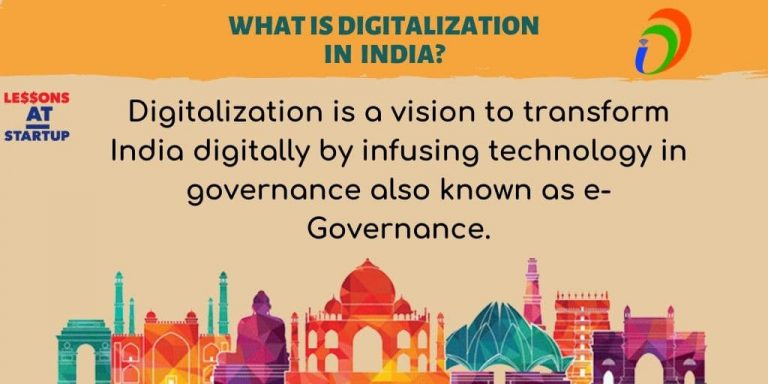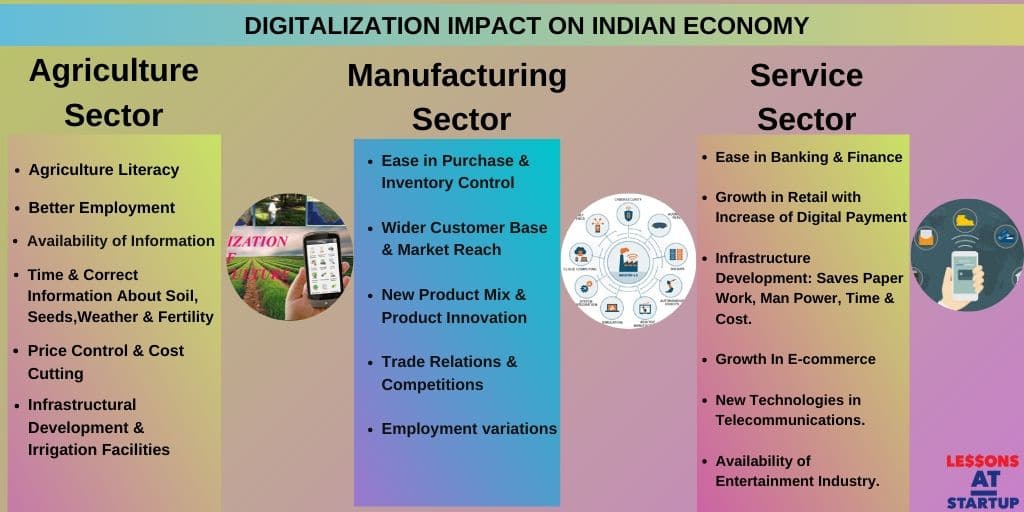How Digitalization has changed the face of Indian Economy in 2024
The number of success stories that have emerged from digitalization and digital India in the last ten years has been remarkable.
Since I am updating this article after a period of 2 years – I am impressed with how much impact digitization and digitalization have had on the Indian economy in the last 2 years (It was last done in 2022 and now is getting a fresh update).
Initiatives like Digital India, Digitalisation, Digitisation, Digital World, etc., have impacted our daily lives.
Everywhere we look, there is a government digital initiative (Adhaar, UPI) that helps foster entrepreneurship and encourages all entrepreneurs in SMEs and other sectors.
Before I start explaining the impact of Digitalisation on the Indian economy and the impact of Digital India.
Let’s first understand the difference between Digitalisation and Digitisation (it’s essential to understand the difference as both initiatives impact the Digital India Initiative directly/indirectly).
Digitization is more related to converting all our data into bits format, and Digitalisation uses different technologies/methods to change business processes.
Though there is a subtle difference between the two, we all use the two words interchangeably, meaning the use of digital methods to improve our business processes.
Think of Digitization as the process by which a small business’s bookkeeping company converts information on paper to online data.
On the other hand, Digitalization could be software like Tally that a self-employed professional might use to do their bookkeeping, replacing pen and paper.
Undoubtedly, the incumbent govt has taken significant initiatives like Digital India under the leadership of Mr. Modi.
Consider this – The 2022 budget’s target of providing optical fibre coverage to the whole country by 2025 was achieved in 2023 by Bharatnet, which has connected over 1.8 Lakh gram panchayats with optical fibre.
India, indeed, is in the digital era!
Impact of Digital India:

Digital India is an initiative by govt of India to help the country adopt digital initiatives.
Initiatives are expected to cut dependency on bureaucratic processes, decrease corruption and help cut downtime in taking public services to the citizens of the country.
The impact of Digital India on India’s economic growth is supposed to be long-lasting. As the initiatives in the Digital India Scheme are all driven by technology.
Some of the key Initiatives of Digital India (2022) were:
- Starting a Digital Locker to help Citizens of India store their important govt ids such as PAN Card, Passport, Voter id card,s and education mark sheets. All the citizens need to use their locker is an Adhaar Card.
- MyGov Portal to improve good governance with help from citizen engagement.
- ORS portal to help citizens of the country to handle online appointments, and pay online fees of doctors and govt hospitals.
- Design Framework to allow the digital signing of documents.
These have been expanded in 2024 to include:
Digital Infrastructure
– BharatNet’s goal is to deliver high-speed broadband connectivity to all gram panchayats in India.
– The National Broadband Mission’s objective is to ensure broadband access to all villages by 2022.
Digital Services
– UMANG (Unified Mobile Application for New-age Governance) serves as a unified platform for all government services.
– DigiLocker provides a platform for the digital issuance and verification of documents and certificates.
– e-Hospital offers an online registration and appointment system for government hospitals.
Digital Empowerment
– PMGDisha (Pradhan Mantri Gramin Digital Saksharta Abhiyan) aims to impart digital literacy to 60 million rural households.
– MyGov is a platform for citizen engagement in participatory governance.
Digital Economy
– BHIM (Bharat Interface for Money) functions as a UPI-based payment interface.
– GeM (Government e-Marketplace) operates as an online platform for government procurement.
– e-NAM (National Agriculture Market) serves as a pan-India electronic trading portal for farm produce.
Digital Security
– Cyber Surakshit Bharat aims to raise awareness about cybercrime and build capacity for safety measures.
– The National Cyber Security Coordination Centre is established to generate situational awareness of existing and potential cybersecurity threats.
Emerging Technologies
– The National AI Portal is a platform designed to showcase AI-related developments in India.
– Responsible AI for Youth is a program aimed at empowering young students with AI skills.
The impact of Digital India now is to :
- Reduce Corruption.
- Increase the speed of public sector services rendered to citizens of the country.
- Decrease documentation.
- Provide an easy-to-manage online storage for all documents.
- Provide simple and easy-to-use cloud space on the internet.
Our governments for years have worked towards creating an economy that is more reliant on the internet and less on the paper-based economy.
The incumbent government gave a single name, “Digital India,” to all the digitization, digitalisation, and other initiatives it took to positively impact our economy.
A quick example of these initiatives’ positive impact is the improved efficiency and reduced paperwork for companies across India.
Today – since the process from GST registration to business tax filing is automated on digital platforms, there is less bureaucracy and faster, efficient service.
Digitalisation and the Indian Economy:
We have unknowingly been a part of Digitisation for so many years.
We have all been part of the Digital World, where we use Digitalised business processes in our daily lives.
Think of activities such as making railway reservations online, buying Air tickets or bus tickets online, or making payments by credit or debit card.
For years, promoting Digitalisation has been a Government initiative to give all services to every citizen on their web portals or electronically, making the transactions transparent and smooth.
The real changes caused by Digitalisation are becoming visible today because of the government’s push, which is expected to usher in a new era (like computerization did in the public and private sectors almost two decades ago). Things like paper currency notes will soon be a thing of the past.
Slowly, we are moving towards the Digitalisation of the Indian Economy with new steps and initiatives.
Digitization, explained in layman’s language, is simple.
“Ab cash saath rakhna jaruri nahi, sab payment phone se ho jati hai” or we don’t have to carry cash all payments can make through phone.
There are certain factors that compel us to follow digitalisation in our routine lives.
In contemporary times, we need certain essential elements to materialize digitalisation in our routine lives.
Why Digitization is the need of the hour:
Corruption today is the biggest problem in developing countries.
In fact, corruption is a problem we have faced for ages.
It is said, a parallel economy flourishes side by side with our main economy. This economy is run by those who avoid paying taxes to the Govt.
One of the prominent reasons for the parallel economy is the dependency on cash-based businesses.
The culprits running the parallel economy do not feel like having bank accounts and other business books which simply means no tax payment to Govt.
With Digitalisation Initiatives like Taxation being bought online and steps like Demonetisation, the government is trying to weed out corruption from our system, which is expected to have a positive impact on the Indian Economy.
Impact of Digitalisation on the Indian Economy:
Digitalization has played a vital role in the flourishing of the Indian economy. The most prominent example is the job opportunities created for youth in the country.
In addition to the above, the “make in India” drive has given youngsters an immense push to start new startups and come up with creative ideas to contribute to India’s digitalization.
The government is pushing and encouraging the Indian public to go cashless and reduce their reliance on cash transactions. The purpose is to make us adopt digital payments.
Here are some key examples of how Digitalisation has helped the Indian economy in 2024:
Economic Contribution:
The digital economy is projected to contribute 20% to India’s GDP by 2026 and is expected to reach $1 trillion by 2025
Job Creation:
IT-BPM sector directly employs about 5.1 million people in 2024, with an Indirect job creation estimated at 12-13 million
Digital Payments:
UPI transactions reached 8.7 billion in volume and ₹14.75 trillion in value in January 2023 and it is expected that Digital payments will account for 71.7% of all payments by volume by 20251
Digital Identity:
Over 1.3 billion Aadhaar cards were issued as of 2023.
Digital Documentation:
DigiLocker has more than 145 million users as of 2023
Digital Infrastructure:
BharatNet connected over 1.8 lakh gram panchayats with optical fibre by 2023
E-Governance:
MyGov portal enhances citizen engagement in governance.
ORS (Online Registration System) facilitates online appointments and fee payments for government hospitals.
Financial Inclusion:
Initiatives like Mudra scheme provide unsecured small business loans without collateral.
Transparency and Anti-Corruption:
Digital transactions reduce the circulation of fake currency and curb black money.
Startup Ecosystem:
Digital India and Make in India initiatives boost startup culture and innovation.
Efficiency in Public Services:
Streamlined processes in taxation, banking, and government services reduce bureaucracy.
Digital Literacy:
PMGDisha aims to make 60 million rural households digitally literate1
Emerging Technologies:
National AI Portal showcases AI-related developments in India
Cybersecurity:
Initiatives like Cyber Surakshit Bharat raise awareness about cybercrime
Digital Agriculture:
e-NAM (National Agriculture Market) provides an electronic trading portal for farm produce
These initiatives and their impacts demonstrate digitalisation’s significant role in transforming the Indian economy and enhancing efficiency, transparency, and inclusivity across various sectors.
Since cash is the primary mode of transactions in money laundering and terrorism funding, a digital society would discourage such laundering and terrorism.
Steps by the Indian Government to improve Digitalisation:
Digital infrastructure’s backbone is the availability of high-speed internet. With the introduction of better and faster mobile internet connections, digitalisation services have been delivered in an efficient way to the citizens of the country.
In addition to the above, the government is implementing initiatives like the “Aadhar Card” or Digital identification for every citizen. The move is expected to give every citizen unique and authentic identification. This step will mean faster subsidy distribution, reduced corruption, and other impacts on our economy.
Digital India has made mobile banking easy.
The next important step taken by the Government is the introduction of a Common Service Centre, a secure public cloud for sharing information (I will not vouch for its safe status, but as per the government, it is safe ).
Digitisation is helping businesses streamline their processes by slowly removing dependency from paperwork.
I think banks are the biggest beneficiaries of Digitalisation.
They now have processes where less staff can do more work.
Digital India has empowered its citizens by giving them digital power, such as the ability to travel without physical documents.
You can show a soft copy of the ticket and identity card, which fulfils the purpose.
The government is pushing for digitalisation in the country by promoting e-services to every citizen.
Another initiative, Digital India, promotes development and creates opportunities for a new India in terms of jobs, technology, and transparency through Digitalisation.
I firmly believe in digitalisation, as this is one step that will help us graduate and turn into an economic powerhouse by cutting down on paperwork and decreasing our dependency on government employees, which will help reduce corruption.
To see the immediate impact of digitisation, we need to analyse how the income tax filing and return processes have been streamlined.
Today, you do not have to stand before an inkstand for an income tax refund.
The government’s new Digital India and Digitization initiatives positively impact the Indian economy and help it go from strength to strength.
No wonder – India is the fastest-growing economy that attracts investments from all across the globe.



